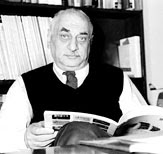
Some thoughts triggered by the short clip we saw in class of
Mississippi John Hurt performing on TV (here in a picture with Skip James, who holds the guitar):
A man who's never left the place where he was born -- 61 years in or near
Avalon, Mississippi. An identity, a root. Attached to a place. Formed by a place. One with that place.
What, if anything, do we gain from travelling the world? From changing environments, friends, partners, even parents? Are we not losing something when leaving a place, a person, a thing...when "
re-placing." Zero-sum game? Can everything about life be learned in one single place, without constantly chasing experiences, adventures, novelties? How about letting these things come to you rather than running behind them, running to find them?
Another man who never left his place of birth...
Immanuel Kant from Koenigsberg (now Kaliningrad, Russia).
A sense of place, a sense of belonging, a sense of identity. A sense of a life actually lived. But then again, Kant's idea of
cosmopolitanism -- where the entire world becomes one's place, where humanity as a whole becomes one's family. How can a man who's never left his town propose such a concept? Is belonging to everywhere possible, or tantamount to belonging to nowhere? Is it an intellectual exercise rather than a physical one?
Should I stay or should I go now? (Not quite 50 years old, but very to the point, this song by "The Clash.") Well, I guess it's time to
leave her, Johnny... (Now, this one is over 50 years old!)














































